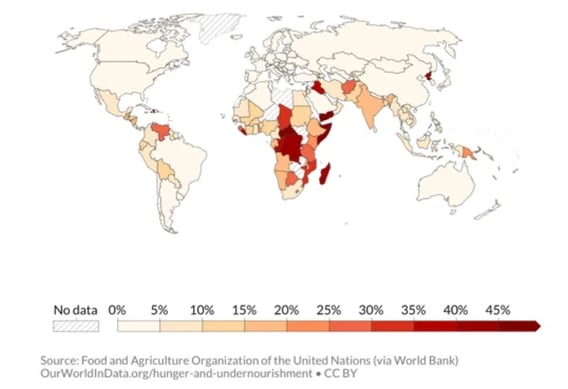Factors Affecting Food Security
- Food consumption around the world is increasing due to:
- Population increase: the world population has now reached 8 billion
- Much of this growth has been in LIDCs and EDCs where people are more likely to suffer food insecurity
- As countries develop people have money to buy more food
- Transport of food is easier and cheaper than in the past
- Population increase: the world population has now reached 8 billion
- Sufficient food is produced to feed the world's population
Food security
- The distribution of food is uneven and this affects food security
Distribution of Undernourished People Globally

Share of people who are undernourished
- Countries where a high percentage of the population are food insecure often have a food deficit
- These tend to be LIDCs as they cannot produce or afford to import enough food to meet the population's needs
- Some countries have a food surplus, these tend to be ACs
- ACs and someEDCs can also afford to import food when they do not produce sufficient for the demand: the UK imports approximately 46% of the food supply required by the population
Factors affecting food security
- There are many factors which affect food supply either in terms of yields or transport into an area
Table Showing Factors Affecting Food Security
| Factor | Affect on Food Supply |
| Climate | Extreme temperatures make growing crops challenging Tropical storms lead to flooding which destroys crops Changing patterns of rainfall impact on yield and can lead to drought or floods Drought can lead to desertification and salinisation which affect crop growth |
| Technology |
LICs lack money to invest in: Machinery Irrigation systems Transport and storage infrastructure This means their yields are lower than in HICs which are able to invest money in this technology |
| Pests and Diseases | Crops and livestock are vulnerable to pests and diseases HICs are able to afford pesticides and treatments to reduce the impact of these on yields LICs are often in tropical areas where pests such as locusts and diseases such as African Swine Flu are more prevalent |
| Water Stress | Water stress affects the ability to irrigate crops due to lack of water LICs are more likely to suffer water stress than HICs due to lack of precipitation and poor infrastructure Lack of irrigation in drier areas leads to low yields |
| Conflict | During conflicts people abandon or are driven off their land leading to large areas of uncultivated farmland Conflict can destroy or block transport routes meaning that food supplies including imports cannot get to where they are needed Conflicts also lead to the destruction of crops and livestock |
| Poverty |
Poverty can mean that people are unable to afford: Technology such as machines Poor diets then mean that people are unable to work due to ill health |
Worked example
Study Fig. 5, a world map showing food security risk index by country.

Figure 5
Describe the pattern for countries with the lowest level of food security risk.
(3 marks)
- 2 marks are awarded for describing the pattern, including anomalies
- 1 mark is awarded for communicating in an appropriate and logical order
Answer:
- The majority of North America and Europe have low levels of food security risk (1) with only about 5 other countries outside of these regions having a low risk of food security (1) (C)




